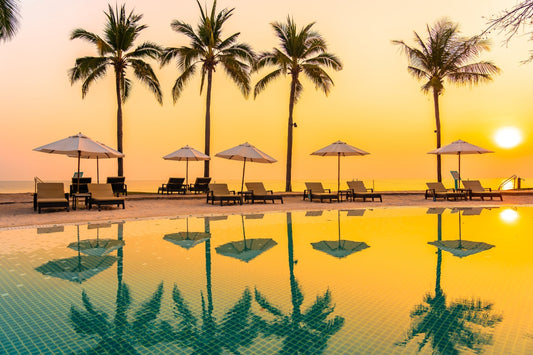The world of travel has undergone significant changes over the years, especially in recent times. One key shift is the growing interest in eco-conscious tourism, or ecotourism. The gaining popularity of this new approach to travel is a reflection of the increasing awareness of our impact on the planet, a rethink of how we travel, and a desire to seek meaningful connections with nature and local cultures.
Unlike traditional tourism, which often prioritizes mass tourism and profit, ecotourism focuses on sustainability, community, and cultural immersion. Eco-travelers immerse themselves in activities that promote environmental conservation, such as wildlife watching, nature walks, and community-based tourism initiatives.
Closer to home, Asia has some of the most beautiful and exotic ecotourism destinations in the world. From scuba diving with whale sharks in the Philippines to adventure caving in Malaysia, here are our top 10 favourite ecotourism destinations in Asia for you to consider for your next adventure.
10. Cameron Highlands, Malaysia
Nestled amidst the verdant hills of Malaysia, Cameron Highlands is a tranquil retreat renowned for its cool climate, lush landscapes, and abundant biodiversity. This scenic hill station is also famed for its sprawling tea plantations. Visitors can learn about the local tea cultivation and sample freshly brewed blends amidst panoramic views. Outdoor enthusiasts can explore nature trails, pick strawberries at strawberry farms and marvel at the diverse flora and fauna, including orchids, pitcher plants, and colorful butterflies.

Experience the iconic tea plantations on Cameron Highlands
9. Khao Sok National Park, Thailand
Khao Sok National Park in Southern Thailand is one amazing place. It is home to one of the oldest rainforests in the world, huge limestone cliffs, deep valleys, stunning emerald lakes, exciting caves and many beautiful animal and plant species. Visitors can go on guided jungle treks, kayak through the Sok River, or stay in luxury canvas tents on Cheow Lan Lake.
Towering limestone cliffs in Cheow Lan Lake
8. Gunung Mulu National Park, Malaysia
The National Park located on the island of Borneo is a UNESCO World Heritage Site renowned for its stunning limestone formations, vast cave systems, and rich biodiversity. Its dense rainforests are teeming with wildlife such as the orang utans, pygmy elements and proboscis monkeys. Visitors can also hop over to the Kinabalu National Park, where Mount Kinabalu is located. The mountain offers fantastic hiking and climbing opportunities and has the highest peak in Southeast Asia. 
The unique Pinnacles rock formation at Gunung Mulu National Park
7. Komodo National Park, Indonesia
Home to their famous inhabitats the Komodo dragons, Komodo National Park is half Jurassic Park, half marine reserve, and all fantastic. It is a UNESCO World Heritage Site that offers incredible diving and snorkeling experiences. Vistors can also explore beautiful beaches, get close to colourful coral reefs, go on islands hopping adventures and of course, see the iconic Komodo dragons up close. 
Discover the Padar Island, Flores, the gateway to the Komodo National Park
6. Donsol, Philippines
Often touted as the "Whale Shark Capital of the World", domestic and foreign visitors alike flock to Donsol to get up close and personal with these gentle giants of the sea. The once-sleepy seaside fishing town is now a booming city for ecotourism. Besides whale sharks, the many dive sites around Donsol are also a great place to see manta rays. Visitors can also spend time to explore pristine beaches, kayak down the rivers, and trek through lush jungles.
 Swim with the whale sharks, the gentle giants of the sea
Swim with the whale sharks, the gentle giants of the sea
5. Ninh Binh, Vietnam
Just 2 hours south of Hanoi, one will find the hidden gem in Ninh Binh. The UNESCO World Heritage Site is filled with stunning natural landscapes - karst mountains, deep valleys and winding rivers. It was the beautiful scenic landscapes that prompted the director, Jordan Vogt-Roberts to pick Ninh Binh to film the blockbuster, Kong: Skull Island. The region also bears many rich cultural and historical attractions. You can enjoy a paddleboat tour in Trang An, trek up to the top of Hang Mua for a panoramic view of the surrounding valleys, and explore the lineup of historical pagodas. 
Soak in the stunning landscape on a boat ride through Trang An River in Ninh Binh.
4. Ladakh, India
Located in the northern part of India, Ladakh is a high-altitude desert region between the Western Himalayas, Tibet, and the Hemis National Park. The area is known for its unique culture and breathtaking natural beauty, such as the Pangong Lake. Ladkh has several sustainable tourism initiatives aimed at promoting responsible tourism practices, including eco-conservation and initiatives aimed at improving the quality of life of local communities. Visitors to Ladakh can engage in a variety of eco-friendly activities, including trekking amidst the towering Himalayan peaks, exploring remote villages to experience traditional Ladakhi culture, and participating in community-based initiatives focused on conservation and sustainable development.
Stunning Pangong Lake in Ladkh
3. Kerala, India
Located in the southwestern coast of India, Kerala is a popular ecotourism destination because of its famed backwaters, lush greenery, and diverse wildlife. There are many national parks and wildlife sanctuaries where visitors can see endangered animal species like tigers, elephants, and the Great Indian Hornbills. Kerala’s backwaters provide a scenic backdrop for eco-friendly houseboat cruises, allowing visitors to immerse themselves in the region's beautiful landscape while minimizing their environmental impacts. There are many other activities that offer you an opportunity to connect with nature like kayaking, rock climbing, and jungle stays in huts.
Cruise over the beautiful backwaters of Kerala
2. Kamaishi, Japan
Kamaishi, located on the Sanriku Coast to the northeast of Japan's main island. This stretch of coastline makes up part of the Michinoku Coastal Trail, created to showcase the region’s beautiful ocean and forest landscape and situated entirely within the Sanriku Fukko National Park. Once known for its steel industry which helped propelled Japan's economic growth, Kamaishi was devastated by a tsunami in 2011. But the city has since transformed into itself into a beacon of sustainability. The city has now turned its sights on renewable energy, including clean energy produced from wind farms and tidal-waves. Today, visitors can explore its pristine beaches, picturesque mountains, and lush forests while learning about the city's remarkable recovery efforts and commitment to environmental conservation.
Remains of the Hashino Blast Furnace, a UNESCO World Heritage site, outside of central Kamaishi
1. Raja Ampat, Indonesia
Raja Ampat, an archipelago comprising over 1,500 small islands located off the coast of West Papua. Here, you will find a nature paradise loved for its enchanting islands, beautiful waters, and magnificent biodiversity. The tourism scene here follows through with an elaborate ecotourism concept, from sustainable resorts to conservation centers and cultural excursions. The locals are warm and welcoming and always make visitors' experience extra special. With all the spectacular wonders above and beyond its waters, this is truly the paradise that one will connect with Mother Nature and bask in the richness of the local culture.

The enchanting islands of Raja Ampat




